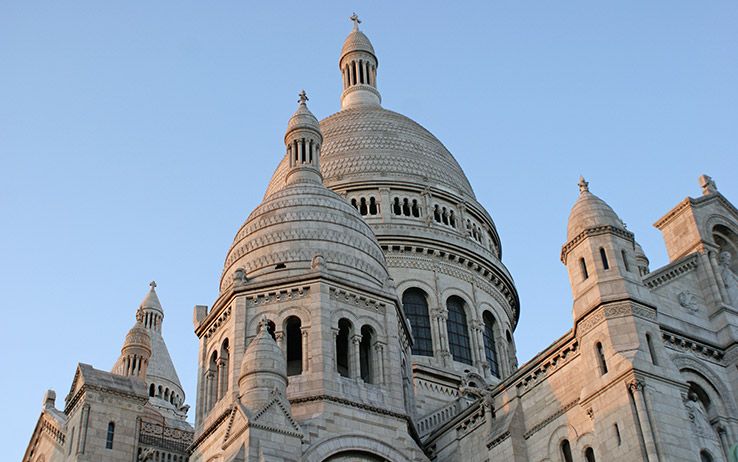Basilique du Sacré-Cœur - an angelic appearance dominating the Parisian skyline and a divine edifice with a "tormented history."
The Basilica of the Sacred Heart, the name translated from the French “Basilique du Sacré-Cœur,” has an extensive number of reasons to be visited. Being the second visited monument in Paris and a popular landmark overall, le Sacre Coeur is a Roman Catholic church and a basilica that arose above the ground on one of the Parisian hills, known as butte Montmartre. The basilica occupies the highest point in the city and magnificently stands for more than a hundred years.

The Sacre Coeur history saw its start back in 1673, two hundred years before the conception of Sacre Coeur Basilica was born, when St. Margaret Mary Alacoque had seen her first vision of the Sacred Heart. The nun, and then Novice Mistress, was an avid promoter of the devotion to the Sacred Heart of Jesus Christ, as she believed a feast must be held in the sign of His heart, His goodness, and His love for humanity, after His words to her.
The vision was declared valid 75 years later, and The Feast of the Sacred Heart became an official solemnity for worshipers and religious people in the Catholic world. It is observed 19 days after Pentecost, on a Friday. The day marks the devotion of His followers who perform daily prayer to the Sacred Heart of Jesus and the fulfillment of His promises as an act of His gratitude for their devotion.
What’s for the Sacré Coeur’s history, it has seen it all, all the ups and downs in the city’s course of events, the birth and death of many, glorious times and terrifying moments. Being built for a total of 39 years, the Basilica of the Sacred Heart now lights up the sky during the day, when its white marble walls reflect the sunlight like it had never seen bad times. Looking at its sublime silhouette that floats above the sky at night like the ground never existed beneath it, you could seize the holy vibe that comes out of its edifice.
Though Sacre Coeur is a religious construction, it is also a prominent cultural and political symbol, having as the premise of creation such events as the birth of the Third Republic, defeat of France in the Franco-Prussian War (1870), and the uprising of socialist Paris Commune (1871). The basilica was constructed in honor of 58,000 people who died in the war and to redeem the crimes of La Commune, after the national voting. The decree that supported the construction was approved on 24 July 1873 and has set the start of the construction.
These historical events impacted the Sacred Heart Basilica’s design as well, being characterized by such national features as the portico, which includes three arches and is “protected” by two equestrian statues of French national saints: King Saint Louis IX and Joan of Arc (1927). Both of the statues are executed in bronze. Another french feature is the tremendous nineteen-ton Savoyarde bell cast in 1895 in Annecy, alluding to the annexation of Savoy (1860).
As Montmartre was already a site of religious means: Druids of ancient Gaul had been gathering here, Romans built their temples dedicated to Mars and Mercury, Church of Saint Peter, the oldest in Paris, has been raised above the ground on this spot, the Montmartre Abbey in the vicinity, and now Basilique du Sacré Cœur shines over them all. The main dome of Sacré Coeur Basilica is seen from any spot in town, so do it - countrysides can be seen on a distance of 50 km.

What’s for the construction of Sacre Coeur, when was it built, you may be wondering. The cornerstone had been set on 16 June 1875 by architect Paul Abadie, after he had won the competition among other 77 architects. The start of the construction had raised many disputes among people declaring it "an incessant provocation to civil war."
In the summer of 1882, Archbishop Guibert defeated the right of the Sacred Heart Basilica to be finished, while Georges Clemenceau, on the other side, supported the rescinding of the 1873 law with regard on property rights, and the Revolution overall, that has been thought to be stigmatized by the church’s construction. Though the law had been rescinded, the basilica was saved as a technicality. Another dispute rose and dropped in 1897 when the interior was almost complete and has been holding services already for six years. Le Sacre Coeur Basilica’s consecration was held on 16 October 1919.
With the help of the pilgrimage, devoted worshipers, and mostly private donations, the church gathered 7 million French francs (approximately $28 million) for its construction. And how people proved their devotion by performing daily prayer to the Sacred Heart of Jesus, so they proved basilica’s importance when it was set to be created by supporting the fund-raising. And how Jesus made His promises to bless those who showed their devotion to His Sacred Heart, so do the contributors were offered to "purchase" individual columns or other features of the edifice as small as a brick.
These days, Basilique du Sacré Cœur is a monument whose walls are filled with silence and divine vibes, that strike the hearts of those who come to pray. It is also a site full of secrets that only those who comprehend its tormented history, its purpose, and its backstory can wholly understand its magnificence.
Now you know more about the history of Sacre Coeur, and particularly when was Le Sacre Coeur built and how it was developed. For more travel inspiration, go back to airflyby.com any time you want, and get pumped up with travel tips, ideas, and outlooks at the most notorious and most unconventional locations around the globe.
Last Updated on December 30, 2019.

